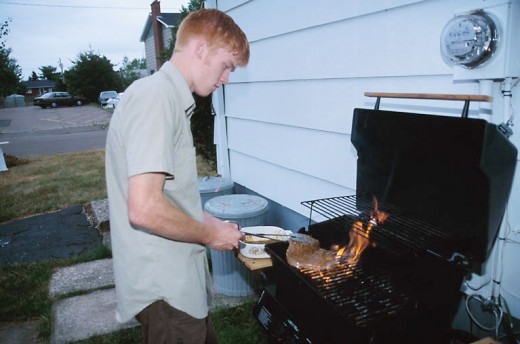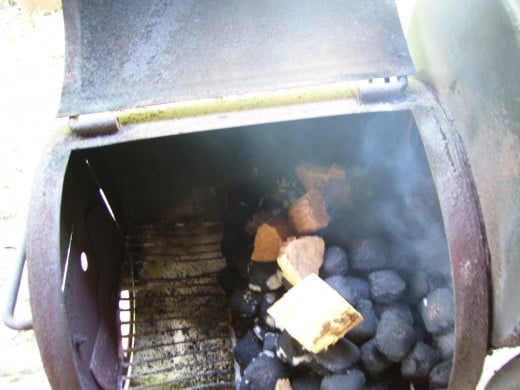Smoke gets in your eyes and in your food, too - Health and Disease

Burning
Summertime is when the outdoor grills and the barbecue pits get fired up and the smoke production ramps up. Some time ago I reported in a journal on the radioactivity of tobacco smoke and the many other cancer-causing compounds in smoke from burning tobacco. After the article was published, a reader sent an inquiry asking what similarly dangerous things might be found in the smoke from his outdoor charcoal cooker. "Is barbecue smoke as dangerous to my health as the smoke from a lighted cigarette," he asked.
The question he asked was a good one, and there was plenty of reason for his asking it, too. I did not have a good answer for him, but I advised him that it would probably be a great idea for him to avoid sticking his head into a cloud of barbecue smoke with a lot of deep breathing. While I still have not personally studied the deleterious effects of breathing dense charcoal smoke and wood smoke from the outdoor cookery, I will stick by my advice – keep your nose out of the smoke. Stick with regular air.
Let’s talk about wood and its burning. This will also include the burning of charcoal.
What is wood? Wood is composed of organic materials, plus inorganic minerals, plus lots of water. Freshly cut wood has lots of water in it, but after wood sits around for a year or two, some water remains but most will be gone. That wood is now called "seasoned." Some of the organic materials in wood are hydrocarbons, many of them volatile (they can evaporate). Some are carbohydrates, a main one of those being cellulose. That is where most of the carbon is to be found in wood. Wood also has a considerable complement of minerals (referred to as ash) of which there is a lot of calcium, magnesium, potassium and some others.
Hydrocarbons burn – witness gasoline, a hydrocarbon not found in wood, by the way (in the event you wondered about that). So does the carbohydrate, cellulose. The wood’s minerals do not burn and are left behind after the rest of the wood goes.

Charcoal and Outdoor Cooking
This gets us to consider the use of charcoal for outdoor cooking fires instead of using wood, green and wet wood for lots of smoke, or well-seasoned and drier wood for some, but not a lot of, smoke. What is charcoal, anyway?
If you put some wood into a closed chamber, away from air and its oxygen, and then heat it to about 1,000 degrees, you will drive everything out of the wood except for its carbon and the minerals, the ash. That’s what you buy at the store – a sack of carbon from wood now liberated of its volatile hydrocarbons and everything else other than its carbon and its minerals. What will be left in it that would likely harm you should you happen to breathe in the heated air above a charcoal fire? The correct answer is "not much."
If there is little or nothing above a charcoal fire other than carbon dioxide from combining carbon with oxygen, why worry? The worry comes from the use of moist wood added to the charcoal fire for the purpose of producing smoke. Why smoke? The smoke is used to add flavor to the foods being cooked. That smoke is not like the invisible carbon dioxide from the charcoal alone. It is visible due to the unburnt hydrocarbons it contains. Those are heated out of the wood and, as they rise away and cool down, they condense and there they are – smoke.
If you are grilling hamburgers or similarly sized meats at high heat directly over a charcoal fire, be aware that the meat contains organic compounds. In the presence of high heat and volatile hydrocarbons found in wood smoke, several probably dangerous compounds are produced – polycyclic aromatic hydrocarbons (PAH) and heterocyclic amines (HCA). Charred meat and charred fats can become loaded with them. They stay with the food and you don’t breathe them in. You swallow them. They are not good for you.
Cutting down the heat of cooking reduces the production of PAH and HCA. Whereas you might grill a hamburger for ten minutes over a bed of glowing charcoal, you would barbecue a ten pound brisket for hours at a temperature of 220 degrees, F. Not only will you avoid lots of probably carcinogenic hydrocarbons and amines, the brisket roast will be more tender and tasty than you might believe possible.
There are several other things you might want to avoid when you do your outdoor cooking with charcoal. It is a good idea to use "lump charcoal" instead of briquettes. Lump charcoal is just charcoal – pure carbon. Briquettes may contain other things used to hold crushed charcoal together. It may not be that easy to find out what those "other things" may be. Also, if you use a liquid starter to get your charcoal fire going, be sure to allow the starter flames to go away completely before you start the grilling or the barbecuing.
Here are some Internet links to information about grilling, barbecuing, and contamination of foods with dangerous compounds encountered in outdoor cooking.









